 |
US Military Aviation
Flight Helmets
US Navy 60s-70s |
 |
At the end of the 50's the APH series helmets introduced a new generation of flight helmets characterized by the external visor covered with a protective shield. Improvement of the communication system, internal liner and oxygen mask retainers was also made and in some versions the dual dark and transparent visors system was installed. These types of helmets were the US Navy and USMC standard jet aircraft headgears during the 60's and throughout the 70's. In this period the first developmet of a flight helmet incorporating the Visual Target Aquisition System (VTAS I) was also made. Furthermore during the late 60's, flight tests have been performed to verify the suitability of a full face "Clam Shell" helmet designed to eliminate the oxygen mask and to give better protection during ejection.
APH-6
This very early version of APH-6 series (still with no letter designation) was introduced during the early 60'. Its shell is constructed of a polyester impregnated fiberglass cloth laminate and the visor shield/locking mechanism was the same as the APH-5 later version as well as the internal liners and earphone fixation system. The APH-6 shell introduce the new and unique "Butterfly" retention and release assembly used to secure the oxygen mask. |
|
| APH-6 flight helmet. This early version of APH-6 serie utilized the same typology of APH-5 visor shield as well as the earphone fixation system still without the large plastic ring under the bolt head. |

|

|
Early 60s US Navy APH-6 flight helmet. (Maurizio Bressan) |
| APH-6 flight helmet in the color of VA-75. This helmet is displayed at Naval Aviation Museum of Pensacola. |

|

|
Early 60s US Navy APH-6 flight helmet with MS22001 oxygen mask. |
| Middle 60s APH-6 flight helmet in the color of VAH-11, with MS22001 oxygen mask. |

|

|
Middle 60s US Navy APH-6 in the color of VF-84 "Jolly Rogers" with US Navy variant of early MBU-5/P oxygen mask. |
| US Navy APH-6 retrofitted with APH-6A earcups and the relevant external plastic washers. The visor housing has been trimmed for a better upper visibility. This helmet is displayed at the Naval Aviation Museum of Pensacola |
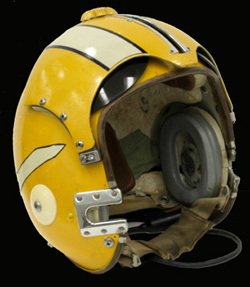
|

|
Middle 60s US Navy APH-6 in the color of VF-111 "Sundowners" (Milehigh). |
| Unusual US Navy APH-6 with APH-5 late bayonet receivers and retrofitted with APH-6A earcups and relevant external plastic washers |

|

|
Probably early 60s US Navy flight helmet prototype based on APH-6 style shell. (Bill) |
| Unusual US Navy APH-6 retrofitted with two visor "ramhorns" kit used on A-6A Intruder early version. This kind of specific connector was used, until the early of the 70, on A-6 aircrafts equipped with GRU-5 ejection seat. it was replaced with standard CRU-79 regulator and REDAR hose when the GRU-7 ejection seat was installed. |

|
 |
APH-6A
The APH-6A was used from the middle of the 60's through the late of the 70's in a large variety of aircraft by the U.S.N. and U.S.M.C. The shell is constructed of a polyester impreganted fiberglass cloth laminate. This model was used with MS22001 oxygen mask and boom microphones were sometimes installed. The oxygen mask was secured by "butterfly" retention and release assembly. The internal earphone were secured by a long screw with the typical large plastic round washer located on both external side of the shell. |
|
| APH-6A flight helmet and MS22001 oxygen mask. This model from 1967 has the marking color of US Navy squadron VF-162 "Hunters" flying the F-8E Crusader during the Vietnam war. |

|

|
This APH-6A of US Navy squadron VF-114 "Aardwarks" shows a modified visor shield with two hand made curved cuts in order to get better upper visibility range. |
| This is a very rare APH-6A version with unusual double visor assembly. This modified APH-6A model was developed by OMNITECH during the late 60's as an alternative version of the APH series (APH-6B and APH-6C) double visors flight helmet. |

|

|

|
Lateral view and internal visor system of an APH-6A with the unusual double visor assembly. This double visors system was made by OMNITECH Company and designed to avoid the possible interference between the upper ejection handle of the seats and the back part of APH-6 helmets during ejection activation. |
| Another APH-6A helmet with the unusual double visor assembly and external boom mounted microphone. |

|

|

|

|
Very interesting APH-6A helmet with the Omnitech double visor assembly probably belong to a Flight Surgeon Officer. |
| Very rare and interesting APH-6A helmet with the OMNITECH double visor assembly in the color of VF-96 "Fighting Falcons" as used during the early of the 70s on F-4J Phantom II. |

|

|

|
Other beautifull APH-6A helmet with the OMNITECH double visor assembly in the color of VA-105 "Gunslingers" as used during the early of the 70s on A-7E Corsair II. |
Lt Cdr Dan Rowley served in RVAH-7 in 1969-70 with his particulary APH-6A modified with a couple of early oxygen mask straight bayonet receivers (the same installed on late APH-5s) directelly applied over the standard APH-6A butterfy mechanism.
(US Navy). |

|

|
This US Navy APH-6A is equipped with an unusual white MS22001 oxygen mask part of a complete white flight equipment (suit, anti-G, harness etc.. ) used by US Navy pilots during the late 50s through the late 60s for nuclear mission. (Bluelight) |
| Unusual APH-6A modified with PRU-36/P double visor system. This helmet was used by a member of VA-196 squadron. (Milehigh). |

|

|

|
APH-6A helmet, used on S-2 Trackers, modified with one-piece ramshorn dual visor, a special energy absorbing liner made of light blue foam, and a front pad of the same type as used in HGU-2A/P and HGU-26/P helmets. (Tomcat) |
| APH-6A helmet of VAW 112 with external boom mounted microphone (Chameloon) |
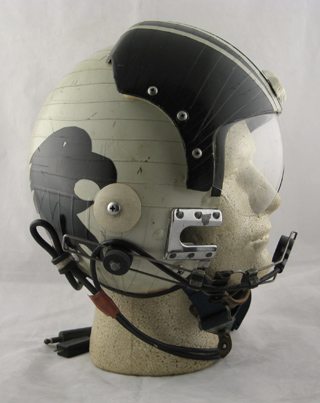
|

|
Unusual APH-6A helmet customized with Hardman "Christmas tree" bayonet receivers as used on APH-5 (Bellsaviation) |
| Another very interesting double Omnitech visor APH-6A helmet, customized with APH-5 oxygen mask bayonets receivers (Maine Military Museum) |

|

|

|
Awesome APH-6A helmet of the VF-74 Be Devilers. This helmet was used by LCDR Walt Bankowski on F-4B Phantom II during the 1966-1967 (Marc Koch) |
| Beautiful APH-6A helmet of the VF-143 "Pukin' Dogs". |

|

|

|
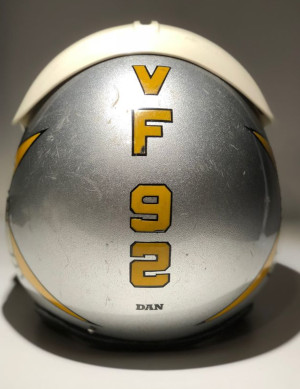
|
Beautiful silver reflective painted Customized APH-6A helmet of the VF-92 Silver King |
| Another Beautiful APH-6A helmet also from VF-92 squadron. |

|

|

|
US Navy APH-6A helmet modified with PRU-36/P double visor system. This helmet is in the color of VAQ-138 |
| Another Beautiful APH-6A helmet of the late of the 60s from VF-14 Tophatters used on F-4B Phantom II. |
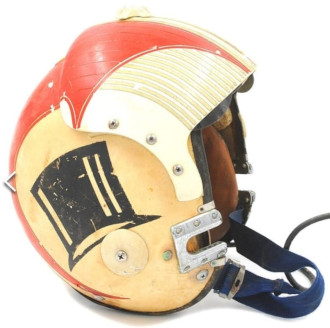
|
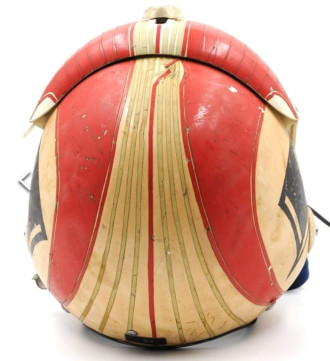
|

|

|
US Navy APH-6A helmet with the OMNITECH double visor assembly |
| Beautiful APH-6A helmet of the middle/late of the 60s from VX-4 Vampires. (AERONANTIQUES.COM) |

|

|
APH-6B
The APH-6B was a dual visor helmet based on APH-6A shell. It was use by U.S.N. and U.S.M.C. pilots in seval typology of jet aircraft both fighters than bombers or strike-fighters from the middle of the 60s through the late of the 70s. As for the APH-6A this model was utilized with MS22001 oxygen mask secured by the "butterfly" retention devices.
It incorporate the earphone and sometimes also an external boom mounted microphone was installed mainly by bomber or strike-fighters crew.
|
|

|

|
Gentex early version of APH-6B with visors knobs as used in some version of APH-5 Helmet during the middle/late 50s. |
| Squadron colored APH-6B with MS22001 oxygen mask, this model has a three piece visor housing assembly with separate locking knob track. |

|

|
This APH-6B model has a one piece visor housing assy. Note the MS22001 oxygen mask with pressure regulator. |
| APH-6B with MS22001 oxygen mask and boom mounted microphone, this helmet has the marking of US Navy Squadron VF-43 "Challengers" of the early 70s. |

|

|
APH-6B model with one piece visor housing assy used by USMC on OV-10 Bronco. |
| APH-6B with MS22001 oxygen mask, pressure regulator and early type of REDAR hose. This helmet has the marking of US Navy Squadron VA-113 "Stingers" of the middle-late 60s when the squadron was flying on the A-4 Skyhawk. |

|

|
US Navy APH-6B of VAQ 308 and Oxygen Mask MS 22001 (Chameloon) |
| USN APH-6B in the color of the RHAH-5 as used during the middle of the 60s. |

|

|
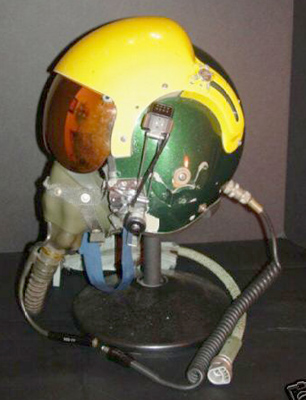
|

|
USN APH-6B equipped with a special nuclear flash protective visor and avionics. |
| USN APH-6B in the color of the VF-32 "Swordsmen" as used during the 70s. |

|

|

|
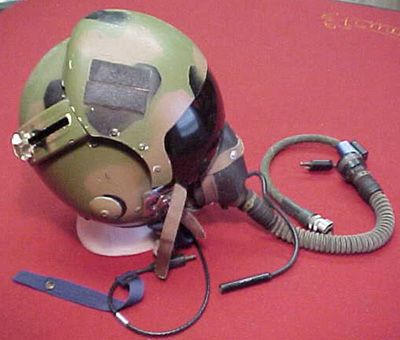
|
Camuflage painted USMC APH-6B belong to Capt Robert George who was flying on A-6 Intruder during the Viet-Nam war. |
| US Navy APH-6B with gold visor (Bellsaviation.com) |

|
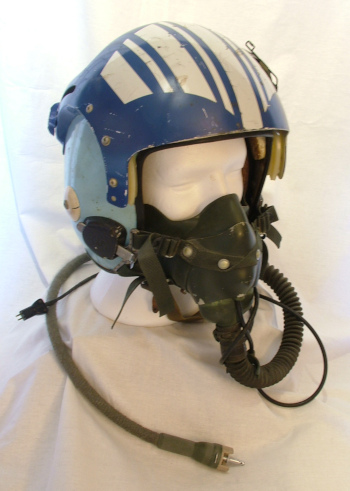
|
Interesting US Navy or US Marines APH-6B of the middle of the 60s with APH-5 late bayonet receivers. |
| Beautifull APH-6B in the color of VF-14 Tophaters used during the late of the 60s of F-4 Phantom. |

|
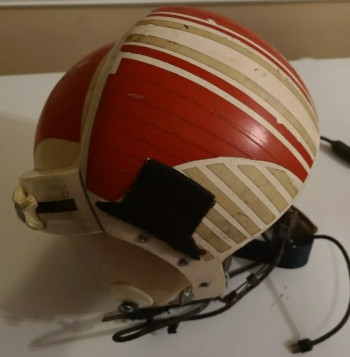
|
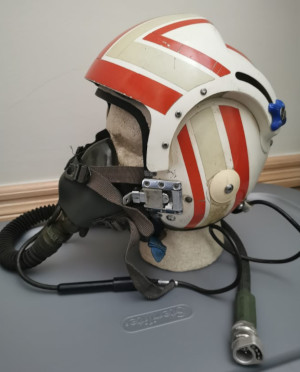
|

|
Interesting APH-6B retrofitted with Sierra "swing-in-a-line" bayonet receivers. Very intersing also the unusual mask shield retainer system. (Ron Chang collection) |
| Beautifull APH-6B in the color of VF-84 Jolly Rogers used during the early of the 70s of F-4 Phantom. |

|
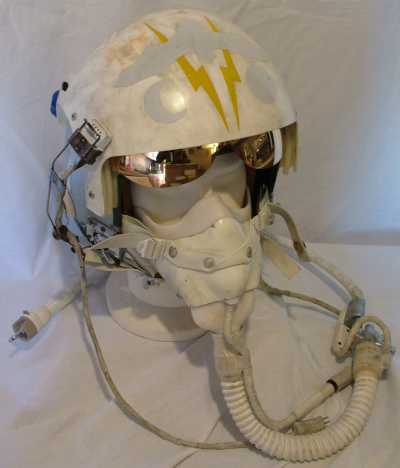
|
US Navy APH-6B from VX-5 used for "nuclear mission evaluation test" during the late of the 60s. |
APH-6C
The APH-6C dual visor helmet is similat to the APH-6B except for the new two-part styrene energy absorbing liner, smaller earcups with plastic-covered earpads and smaller fitting pads. |
|
| U.S.N. APH-6C with VAQ-131 squadron marking. This helmet was used during the 70s on EA-6B Prowler. |

|

|

|
U.S.N. APH-6C manufactured by Sierra Engineering. The main changes introduced were a new two-part styrene energy absorbing liner, smaller earcups with plastic-covered earpads and smaller fitting pads. (Chad Le Beau) |
| USN APH-6C with VF-111 squadron marking. This helmet was used during the 1969 on F-8H Crusader. |

|

|
US Navy APH-6C of VAQ 132 with MS 22001 oxygen mask (Chameloon) |
| Unusual USN APH-6C with "swing a line" bayonet receivers. This kind of attachments were normaly used on some Sierra and protection Inc. APH-6 Custom fit |
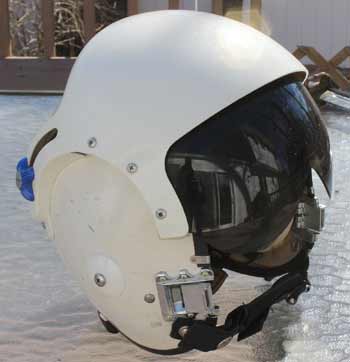
|

|
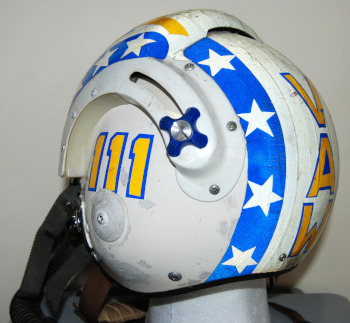
|
US Navy APH-6C of VAW 111 with MS 22001 oxygen mask |
| US Navy customized APH-6C with MS 22001 oxygen mask. In this helmet a central support has been added to avoid possible interference between the upper visor housing and the seat ejection handle during its pulling for ejection sequence start. |
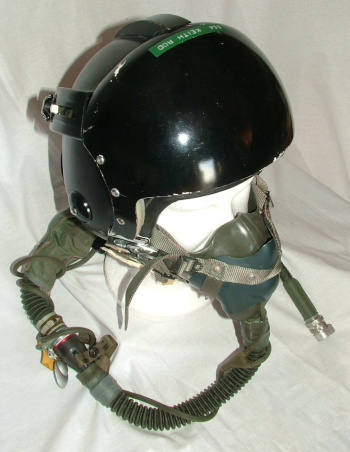
|

|

|
US Navy APH-6C with modified MBU-5/P used on A-6A Intruder in 1970. This kind of specific connector was used, until the early of the 70, on A-6 aircrafts equipped with GRU-5 ejection seat. it was replaced with standard CRU-79 regulator and REDAR hose when the GRU-7 ejection seat was installed. |
| US Marines APH-6C in the color of VMFA-122 "Flying Leathernecks" used during the late of the 60s |

|
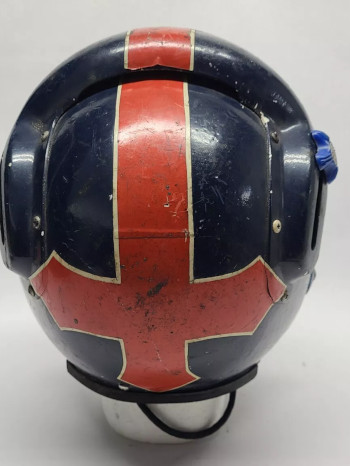
|
APH-6D
The APH-6D single visor visor helmet is similat to the APH-6A except for the new two-part styrene energy absorbing liner, smaller earcups with plastic-covered earpads and smaller fitting pads. |
|
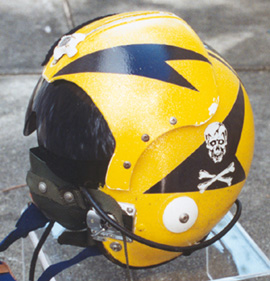
|
US Navy APH-6D in the color of VF-84 used during the late 70s. This helmet is displayed in the Naval Aviation Museum of Pensacola. |
| The APH-6D is similar to the APH-6A except for the new two-part styrene energy absorbing liner, smaller earcups with plastic-covered earpads and smaller fitting pads. (Tomcat) |

|

|
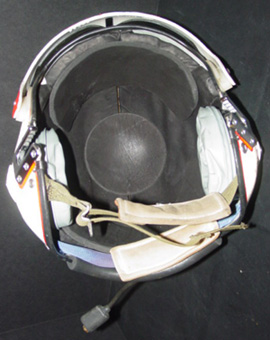
|
U.S.N. APH-6D in the colour of VF-96 this specimen is fitted with custom fit internal pads. |
| USMC APH-6D with external boom mounted microphone as used on OV-10 Bronco during the late 60s early 70s |

|

|

|

|
US Navy APH-6D in the colour of VF-74 with MS 22001 Oxygen mask.
this helmet belong to the VF-74 CO CDR Felix Templeton (www.bellsaviation.com) |
| US Navy APH-6D in the colour of VA-27 Royal Maces. This specimen has been retrofitted with internal cloth liner attached to the ear-pads and was used on A-7E Corsair II during the 1979-1980 |

|

|

|

|
APH-6D with MS22001 pressure regulator and REDAR hose in the configuration used on T-2 Buckeye during the middle-late of the 70s.
|
| USMC Customized APH-6D in the colour of VMFA-115 Silver Eagle and US Navy variant of MBU-5/P. This specimen has been used by Capt. Gary Graves on F-4J during the middle of the 70s. |

|
DH-101 Bonnet (APH-6 shell)
The Gentex DH-101 Bonnet was the first nuclear flash protective helmet assembly. It was developed during the early 60s as an experimental nuclear protective helmet. The DH-101 Bonnet was equipped with a huge protective shield placed all around the frontal part of the helmet's shell. This helmet has a modified visor with central knob attached directely on the glass, lateral tracks assy allow the visor movement under the protective shield hose.
|
|
| The Gentex DH-101 was the very first flash blinder helmet developed to protect pilots against nuclear flash blinders. (Gentex) |

|

|
The Gentex DH-101 was based on APH-6 shell modified with protective shield . (Gentex) |
 |
DH-101A and DH-102 (APH-6 shell)
The DH-101A was a nuclear flash protective helmet assembly. It was used during the half of 60s by US Navy as an experimental nuclear protective helmet. The DH-101A was manufactured by Omnitech Incorporated and is based on a standard APH-6 shell.
The special visor, automatically darkned after a nuclear flash, operates by ink material sprayed on the inner surface of the two visor lenses. The ink was sprayed by an explosive cord that lies at the sensor at the top of the visor between th two lenses when receiving a trigger pulse initiated from the sensor at the top of the helmet through an electronic box carried in the pilot's pocket. The pilots had to carry extra lenses to replace the old one after experiencing a "black out". The DH-101A assembly was manufactured in two models designed by Omnithec Icn. as 144A (large) and 144B (medium).
DH-102 light sensor was wired into the aircraft while the DH-101A has the light sensor built into the helmet.
|
|
| DH-101A with external boom mounted microphone. The helmet has not yet been fitted with a chin snap or oxygen mask receivers but the manufacturer documentation shows that the helmet was indeed meant for use with oxygen mask as well. |

|

|
In this DH-101A the location for the nuclear flash sensor it is visible in the frontal area just above the visor frame. (Schiffer publishing Ltd.) |
| Lateral view of DH-101A nuclear flash protective assembly. This helmet was developped in two models designed by Omnitech Inc. as 144A (large) and 144B (medium). (Bloodhound) |

|

|
DH-101A with oxygen mask bayonet receivers oxygen mask MS22001 and electronic box. (Bluelight) |
| Complete nuclear mission protective assembly compoused by DH-101A helmet and white MS22001 oxygen mask. (Bluelight) |

|

|

|
DH-102 with oxygen mask bayonet receivers of the same type used on late APH-5. (Bluespicker) |
| In the DH-102 the light sensor was wired into the aircraft while the DH-101A has the light sensor built into the helmet. (Bluespicker) |

|

|

|
Beautiful specimen of US Navy DH-102 tested during the middle of the 60s |
 |
APH-7 ; DH-71
The APH-7 is similar to the APH-6A except for the strap suspension assembly and externally adjustable neckstrap instead of the standard fitting pads.
The DH-71 was probably a precursor of the APH-7 based on early APH-6 helmet but it also has a strap suspension assembly and an external adjustable nape strap.
|
|

|
US Navy APH-7 helmet made by Gentex with MS22001 oxygen mask. Except for the internal liner the design it is similar to the APH-6A helmet (Flighthelmet.com) |
| APH-7 helmet dated 1965 manufactured by Gentex.This model was probably developed for occasional passengers while regular crewmembers would have an APH-6 fitted specifically to that individual using fitting pads. (DocBoink) |

|

|
DH-71 helmet made by Gentex. Because its USAF standard communications and CRU-87P oxygen connector, this particular helmet could had been used by US Navy pilot who possibly was an exchange pilot with the USAF or flew an aircraft type that had USAF com. requirements. (Milehigh) |
| Side view Comparison between DH-71 and APH-7. Note the external adjustable nape strap located on the lateral aft part of the shell. (Milehigh) |

|

|
APH-7 of VF-111 "sundowners" retrofitted with APH-6B one piece housing. This helmet used on F-8C Crusader in 1967 is displayed in the Naval Aviation Museum of Pensacola (Maurizio Bressan) |
| US Navy APH-7 used durind the middle of 60s with oxygen mask MS22001. |

|

|
APH-7 of RVAH-5 retrofitted with APH-6B three pieces housing. This helmet was used on RA-5C Vigilante during the 60s. |
| Very interesting US Navy APH-7 dated 1965 retrofitted with APH-6B one piece housing and customized with aluminum cast straight bayonet receivers and gold visor. |

|

|
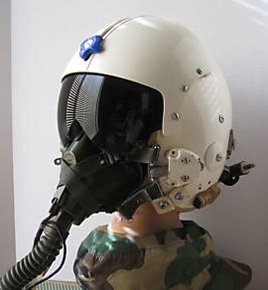
|

|
APH-7 with cast bayonet receivers and unusual APH-5A like USAF-standard communications. (jerrold520)
|
| Beautiful US Navy APH-7 with the marking of the VAH-10 flying on A-5 Vigilante. |

|
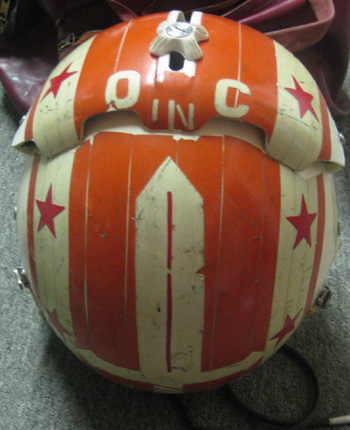
|

|
Another very interesting APH-7 with cast bayonet receivers, double visor, USAF-standard communications and MBU-5/P oxygen mask.
|
| US Navy APH-7 with the marking of the VF-21 flying on F-4J Phantom II during the early of the 70s. |

|
 |
BPH-1 ; BPH-2
The BPH-1 (Gentex designation DH-51-4 and later DH-111) was used by U.S.N. and U.S.C.G. in the mid 60s early 70s in reconnaissance and patrol aircraft, as well as, without the visor system, for crew and flight deck use (designation DH-144-1). The shell is constructed of a fibergalss cloth reinforced with epoxy resin, it is compoude by H87B/U receivers and boom mouned microphone M-87/AIC. A neutarl grey visor was normally installed on this helmet which could be also replaced with a clear one.
The BPH-1 was soon replaced by the BPH-2. The major differences between the two helmets are in the brackets attached around each earcup to hold the earcup tightly to the wearers head, and in the attenuaton relief valve that was changed for the BPH-2. |
|

|
US Navy BPH-1 helmet with external boom mounted microphone. (Flightgear on line) |
US Navy BPH-2, note the external receivers and the snaps on leather/cloth liner similar to the one installed on some helicopter helmets typology. (Schiffer Publishing Ltd.)
|

|
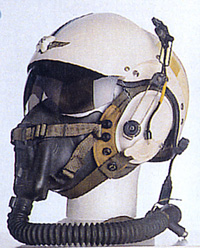
|
US Navy BPH-1 helmet with MS22001 oxygen mask attached on helmet's lateral snaps, the external boom muonted micrphone it is also visible. |
Beautiful U.S.N. BPH-1 flight helmet
|

|

|

|
US Navy BPH-2 used during the 70s. |
HGU-7/P
The Gentex HGU-7/P helmet for the US Navy was a modified version of the U.S.A.F. HGU-7/P and was used by crew members of cargo, trainer and tanker type aircraft. The helmet constructed of an injection molded polycarbonate material was equipped with boom mounted microphone, headset and removable sun bill. B-8 googles could also be used. |
|
| US Navy Gentex HGU-7/P with boom mounted microphone and removable sun bill. (Gentex) |

|

|
The headset was secured by means of two adjustable metallic tracks. (Gentex) |
 |
AOH-1 Experimental helmet
The US Navy program called the Aviator's Oxygen Helmet (AOH-1) leds to the development of integrated oxygen breathing and crash protective helmets. This prototype helmet was designed to protect jet pilots, especially during high-speed bailouts. It simply integrated the O2 breathing into the area around the front of the pilot's face, which was sealed off from the rest of the helmet by an air-damming seal.
Only the faccial area was exposed to the incoming oxygen and no oronasal mask was needed. The aft 2/3rds of the helmet was open to ambient (cockpit) air and pressure. The AOH-1 Experimental helmet was also tested by USAF during the late 50s early 60s. The AOH-1 was eventually rejected because it was cumbersome and hard to put on quickly during alerts. |
|
Early experimental helmet AOH-1 tested during the 1955 on F-100 Supersabre. (USAF)
|

|

|
AOH-1 Experimental Helmet. This specimen was tested by USAF Colonel Norman J. Champion of the Air Defence Command |
This experimental AOH-1 helmet was the precursor of the US Navy HGU-20/P "Clam Shell" helmet and was flight tested during the end of the 50s till half of 60's.
|

|

|
The frontal part of the helmet, with the air-damming seal and microphone, was completelly removable from the aft part which integrate the linen and earphones. |
| A Naval Air Test Center pilot on F-8E "Crusader" wearing an AOH-1 experimental helmet during the half of 60's. (US Navy) |

|

|
USAF test pilot John Fitzpatrick is testing the AOH-1 helmet on a F-106 at Edwards AFB in the 1958 (USAF) |
| "Clam shell" prototype helmet probably precursor of AOH-1
|

|
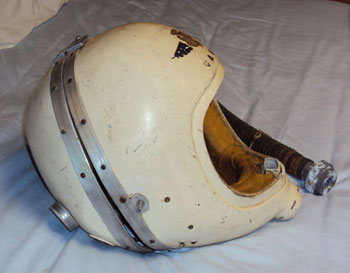
|
 |
HGU-20/P
The U.S.N. HGU-20/P (designation assigned in 1968) was developed from the AOH-1 program. This "Clam Shell" helmet was based on the previous U.S.A.F. HGU-15/P (tested during the 1963-64 on F-104 and F-105).
The helmet with clear visor, neutral grey visor and M-94A/A microphone, was flight tested in fighter and fighter-strike aircrafts from the late 60s to the early 70s. Because of his excessive weight, restricted bilateral peripheral vision and the chin section snagging on chute harness capewells (while checking 6), the pilots considered this helmet not suitable for operative flight and high-G maneuvers. |
|
This HGU-20/P was used by Naval Flight Officer (NFO) in F-4 fighter. Note the visor locking knob and the M-947A microphone.
(Schiffer Publishing Ltd.)
|

|

|
The nick-name "Clam Shell" comes from this particulary opening system of the two helmet's halves. Note the shell locking mechanism and internal webbing adjustment knob.(Schiffer Publishing Ltd.) |
| A-7A Corsair II pilot of US Navy squadron VA-86 wearing an HGU-20/P. The immages was taken on USS Coral Sea during the Vietnam war operative mission in 1969. (US Navy) |

|

|
US Navy HGU-20/P. The pilots considered this helmet not suitable for operative flight and high-G maneuvers. |
| US Navy HGU 20/P displayed at the Naval Aviaton Museum of Pensacola. |

|

|
Internal view of US Navy HGU-20/P. |
| US Navy HGU 20/P with REDAR hose . |

|

|

|
Beautiful US Navy HGU-20 with squadron marking. (bellsaviation.com) |
| US Navy HGU-20/P used during the 1967 on RF-8 Crusader of VFP-62 |

|

|
Beautiful US Navy HGU-20/P. (Philippe Tondeur collection) |
| US Navy HGU-20/P probably used on F-4 Phantom of VF-101 (Steven Wilson) |

|

|

|
US Navy HGU-20/P used during the evaluation test flight on F-111B during the late of the 60s. |
| US Navy HGU-20/P with REDAR hose used on F-8 Crusader |

|

|
 |
HGU-27/P (DD-61)
On January 30, 1970, Naval Air Engineering Center, Philadelphia requested assignment of nomenclature (DD-61) from the Aeronautical Systems Division at Wright Patterson Air Force Base, for “Helmet, Pilot, Aircrewman’s HGU-27/P”. Under DLA policy, the three letter type designation “HGU”, was under the custodianship of the USAF ASD, and all new assignments were made by them.
Under “Functional description” on the DD Form 61 Request for nomenclature: Used by pilot and crewman, engaged in anti-submarine warfare, to provide protection against head and eye injury and hearing loss.
From Naval Aviation News, July 1978, page 10, it mentions that a Mobile Helo Crewman helmet, with radio (HGU-27/P) was under development. The US Navy was using helicopter mounted ASW equipment (SONAR) to track submarines and the HGU-27/P was being tested for use in this role. It semms that during the middle of the 80s many SONAR operators wore special helmets to blot out ambient noise and the HGU-27/P was a test helmet. |
|
HGU-27/P (DD-61) flight helmet tested during the 70s with double visors system similar to the one made by OMNITECH Company
|

|

|
Other configuration of HGU-27/P. The Type designation sheet of this helmet does not indicate the helmet was standardized, no specifications were issued. |
| Another Interesting US Navy HGU-27/P with double visors system similar to the one made by OMNITECH Company. |

|

|
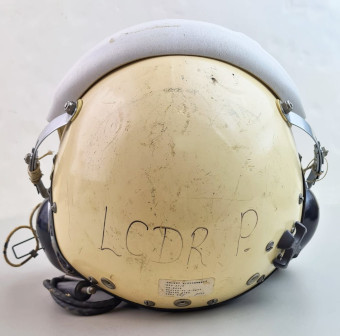
|
Rear view of the same US Navy HGU-27/P. |
 |
HGU-30/P (APH-6A VTAS I)
The US Navy were the first to utilize an operational helmet-mounted sight system in a fighter aircraft during the early 70s, the Visual Target Acquisition System I (VTAS I). The VTAS is a head position referencing system which provide the target aquisition informations/lock-on directelly on pilot's line-of sight during the air-to-air combat.
The system interfaced with the Sidewinder Expanded Acquisition Mode (SEAM) installed in US Navy F-4J Phantom II aircraft to exploit the advanced lock-on possibilities in the AIM-9G Sidewinder air-to-air missile. This system used a "Granny glass" sight piece that was deployed and stowed inside the visor using a slide knob located on the helmet shell. |
|
During the early of 70's this APH-6A incorporating the Visual Target Aquisition System (VTAS) takes the designation of HGU-30/P. The VTAS system was manufactured by McDonnel-Douglas, Gentex and Sierra are the helmet manufacturers. (Schiffer Publishing Ltd.)
|

|

|
The VTAS I system was later incorporated in PRK-41/P helmet shell (same as DH-151 but drilled for VTAS I system). This configuration takes the designation of HGU-30A/P |
| This VTAS I system was incorporated in PRK-41/P shell with a APH-6B double visor housing |
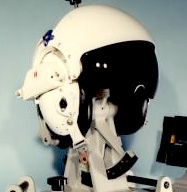
|

|
VF-154 F-4J crewed by LTJG Jim "Ox" Van Hoften.
The helmet he's wearing is a first-generation Visual Target Acquisition System (VTAS) helmet, with the "granny glass." This was an eyepiece that flipped down in front of the pilot's right eye and provided a reticle and lights around it to tell him of the radar's and/or Sidewinder's status (locked or not... and whether he's looking in the same piece of sky as the radar).
The VTAS system was nice when it worked, but the VTAS sensors added additional mass to the helmet (not so good in ACM) and required the radars to be tweaked to a high degree. Also, the helmet had fragile sensors mounted on it, and usually lost the battle between helmet and passageway sides. Some pilots used it and liked it, others tried it and then never used it again. (Photo by LTJG Jan Jacobs, USN)
|
| Beautiful US Navy VTAS I flight helmet displayed in the Air and Space Museum |

|

|

|
NATOPS data sheet of VTAS I flight helmet |
|









































































































































































